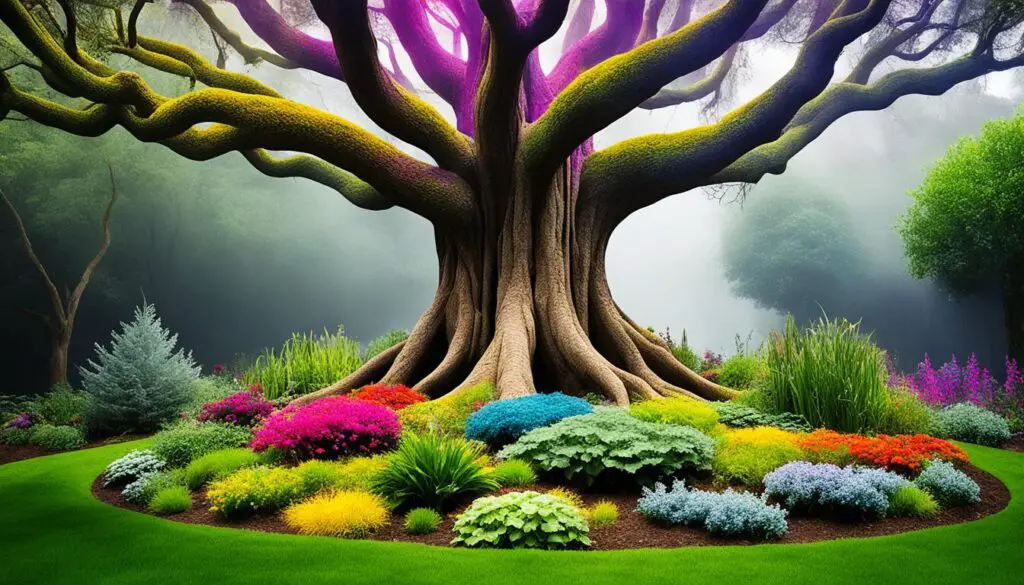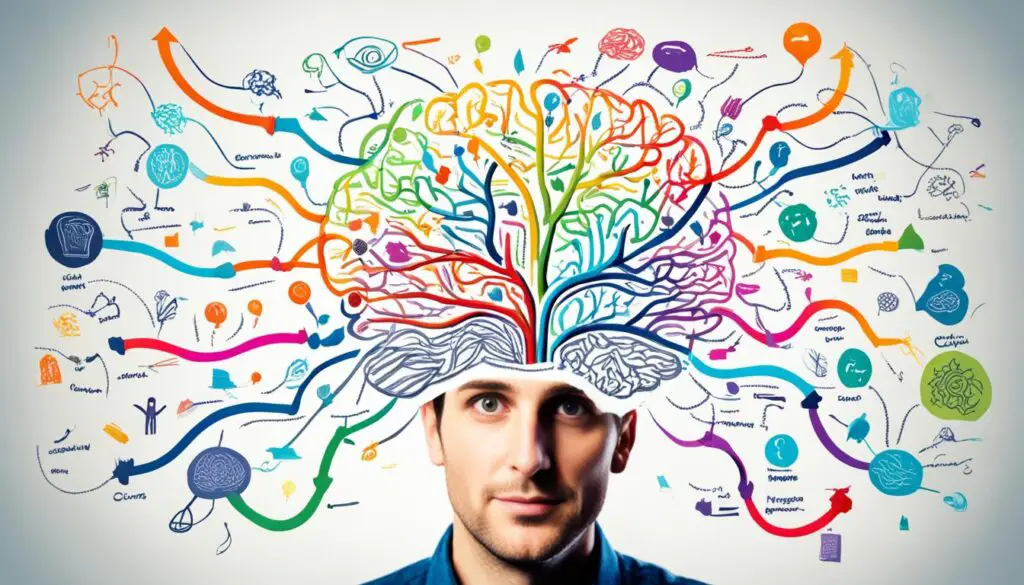Mind mapping is a great way to organize your thoughts and be more creative. It lets you see your ideas visually and doesn’t follow a straight line – just like how our brains work. And because we have so many thoughts each day, staying organized is key.
This method not only makes your thoughts clearer. It also helps you remember things better and makes complex information easier to understand. It’s perfect for brainstorming, learning, solving problems, and sharing information.

Key Takeaways:
- Mind mapping is a visual technique for organizing thoughts and boosting creativity.
- Mind maps provide a holistic view of a subject and enhance memory retention.
- Mind maps can be used for brainstorming, learning, problem-solving, and presenting information.
- Mind maps can be created using different colors, keywords, images, and symbols to reinforce structure and aid in recall.
- Mind mapping is a valuable tool for organizing thoughts and generating new ideas in a visually engaging way.
The Benefits of Mind Mapping for Creative Thinking
Mind mapping boosts creative thinking in many ways. Its dynamic, non-linear style is perfect for brainstorming. It helps make quick connections and organize ideas. This visual approach makes learning and remembering things easier.
Mind mapping lets us think differently. It connects ideas in new ways, and sparks creative thinking. By visually showing our thoughts, it unlocks our imagination for new ideas.
Also, mind maps can spice up presentations by making info more interesting. They’re great for any creative project. They help from idea creation to organizing and sharing info well.
Boosting Creativity
Mind maps let ideas flow freely. They encourage thinking in new ways by showing hidden connections. This makes coming up with fresh ideas and ways simpler.
Enhancing Learning and Memory Retention
Seeing information visually involves both the creative and logical sides of our brain. This helps us learn and remember complex topics better. A mind map’s layout also helps us remember info more easily.
Facilitating Problem-Solving
Mind maps change how we see problems and explore solutions. They support a detailed examination of options, leading to creative answers. The map’s visual approach helps us consider all parts of a problem or decision.

| Benefits of Mind Mapping for Creative Thinking | Description |
|---|---|
| Enhanced brainstorming | The dynamic nature of mind maps allows for quick associations and organization of thoughts, stimulating creative brainstorming sessions. |
| Improved learning and memory retention | Visual representation of information in mind maps aids in absorbing complex knowledge and concepts, enhancing learning and memory retention. |
| Effective problem-solving | Mind mapping encourages a multidimensional exploration of ideas and choices, facilitating a holistic approach to problem-solving. |
| Engaging presentations | Mind maps can be used as visual aids in presentations, making information more engaging and memorable for the audience. |
Mind mapping is a powerful, flexible tool. It boosts creative thinking, improves learning, helps with problem-solving, and makes info more understandable and fun.
How to Create Effective Mind Maps
Creating a great mind map needs thinking and detailed work. Start with a main topic. Use simple words or phrases to show your ideas. Then, put them in a layout, with the main theme coming from a central image. You can use colors to group and highlight ideas. This helps to see the map’s structure and info flow better.
Tools like Lucidspark make mind maps easier and nicer to look at. They offer many features to add images, symbols, and various line types. These features really make your map pop. So, be creative. Try various ways to visually share your thoughts and ideas.
Keep your mind map easy to follow, especially in team work. Setting basic rules can make everyone understand better, which improves teamwork.

Example: Mind Map Creation Process
| Steps | Description |
|---|---|
| 1. Identify central topic | Pick a main idea or topic as the center of your map. This is what your map will revolve around. |
| 2. Add main branches | Put main branches off the central topic. These are the big categories or subtopics of your core idea. |
| 3. Include subtopics | Under each main branch, add subtopics. This builds up more details and ideas for each category. |
| 4. Use colors and keywords | Color-code each main branch. Then, use short phrases to tag the ideas within each branch. This makes everything clear and easy to find. |
| 5. Incorporate visual cues | Add images, symbols, and varied line styles. These elements show the meaning and links between parts of your map. |
| 6. Review and refine | Keep checking and tweaking your mind map. Ensure it’s clear, logical, and accurate. Make changes and add things to help your understanding and how you share it. |
Follow these steps and use tips like colors, keywords, good software, and visual hints. This way, you’ll make mind maps that are easy to understand, organize, and share your thoughts and ideas.
Conclusion
Mind mapping is a great way to get organized, be more creative, and solve problems. It shows your ideas visually, which is good for the creative side of your brain. It’s not just about remembering stuff. You can use it for coming up with new ideas, learning, managing projects, and making presentations.
Pairing mind mapping with techniques from cognitive behavior therapy can also help. This means looking at your thoughts and challenging those that might not be true. It’s a way to deal with negative thoughts in a structured, logical way.
Adding mind mapping to your daily routine can change how you think. It makes everything clearer and more organized. Mind mapping is a powerful tool. It helps with creativity and solving problems better. So, dive into mind mapping. Use it to think more clearly and creatively every day.
FAQ
What is mind mapping?
Mind mapping organizes thoughts and boosts creativity. It uses a visual way to show ideas. A main topic is at the center. It branches into subtopics with details.
How can mind mapping enhance creative thinking?
Mind mapping is a creative way to brainstorm. It allows for quick connections and organizing of thoughts. This method also helps in learning, memorization, and solving problems. By visualizing information, it encourages looking at ideas in more than one way.
What are the benefits of mind mapping?
Mind mapping boosts creativity and memory. It makes complex information easier to understand. This method helps in problem-solving. It also makes presentations more engaging.
How do I create effective mind maps?
Start by picking a central topic. Use simple words or phrases for thoughts. Arrange them from the central image in a hierarchy. Color-code to make sections clear. You can also use images and symbols. Mind mapping software can be helpful too.
Can mind mapping be used in collaboration with others?
Yes, mind mapping is great for teamwork. Keep the map simple and clear. Set rules for the team to follow. This helps everyone communicate better.
How does mind mapping complement cognitive behavior therapy?
Mind mapping works well with therapy. It helps in understanding and challenging negative thoughts. This makes therapy more structured and analytical.
What is the importance of mind mapping in daily life?
Mind mapping brings order and creativity to our thoughts. It’s a great way to organize ideas. It also helps in solving problems better.






